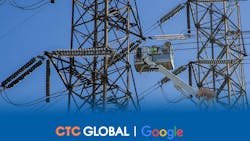Google and CTC Global Partner to Fast-Track U.S. Power Grid Upgrades
On June 17, 2025, Google and CTC Global announced a joint initiative to accelerate the deployment of high-capacity power transmission lines using CTC’s U.S.-manufactured ACCC® advanced conductors. The collaboration seeks to relieve grid congestion by rapidly upgrading existing infrastructure, enabling greater integration of clean energy, improving system resilience, and unlocking capacity for hyperscale data centers. The effort represents a rare convergence of corporate climate commitments, utility innovation, and infrastructure modernization aligned with the public interest.
As part of the initiative, Google and CTC issued a Request for Information (RFI) with responses due by July 14. The RFI invites utilities, state energy authorities, and developers to nominate transmission line segments for potential fast-tracked upgrades. Selected projects will receive support in the form of technical assessments, financial assistance, and workforce development resources.
While advanced conductor technologies like ACCC® can significantly improve the efficiency and capacity of existing transmission corridors, technological innovation alone cannot resolve the grid’s structural challenges. Building new or upgraded transmission lines in the U.S. often requires complex permitting from multiple federal, state, and local agencies, and frequently faces legal opposition, especially from communities invoking Not-In-My-Backyard (NIMBY) objections.
Today, the average timeline to construct new interstate transmission infrastructure stretches between 10 and 12 years, an untenable lag in an era when grid reliability is under increasing stress. In 2024, the Federal Energy Regulatory Commission (FERC) reported that more than 2,600 gigawatts (GW) of clean energy and storage projects were stalled in the interconnection queue, waiting for sufficient transmission capacity. The consequences affect not only industrial sectors like data centers but also residential areas vulnerable to brownouts and peak load disruptions.
What is the New Technology?
At the center of the initiative is CTC Global’s ACCC® (Aluminum Conductor Composite Core) advanced conductor, a next-generation overhead transmission technology engineered to boost grid capacity without the need for new towers or expanded rights-of-way.
Unlike traditional conductors such as ACSR (Aluminum Conductor Steel-Reinforced), ACCC conductors use a lightweight composite core made of carbon and glass fibers, surrounded by high-conductivity aluminum strands. This design allows the conductors to carry significantly more current while reducing line losses and thermal sag, two key limitations of legacy steel-reinforced designs.
The result is a conductor that can double the capacity of existing lines, improve energy efficiency by reducing resistance-related losses, and enhance long-term reliability under high thermal loads. For utilities and large energy users such as hyperscale data center operators, ACCC offers a critical tool for modernizing the grid within existing physical constraints, accelerating time-to-impact without triggering years of permitting and construction.
Why Grid Modernization Matters
The U.S. power grid is straining under the weight of aging infrastructure and growing demand. More than 70% of the nation’s transmission lines are over 25 years old, and many core components (transformers, substations, circuit breakers) are operating well beyond their intended design life. Across most of the country, deferred maintenance and backlogged upgrades have created reliability vulnerabilities that increasingly threaten both residential stability and industrial growth, particularly for power-intensive sectors like data centers.
Transmission bottlenecks have become a critical chokepoint. The U.S. grid lacks sufficient high-voltage, interregional transmission capacity, especially the flexible, modernized infrastructure needed to connect variable renewable generation with areas of peak demand. When the grid was originally built, it was optimized for centralized fossil fuel power plants, not the decentralized, intermittent generation patterns of today’s solar and wind projects. Nor was it designed for the rapid, high-density demand surges associated with AI-driven data centers or EV charging infrastructure.
The result is visible across multiple regions. Without adequate long-duration storage or flexible transmission pathways, renewable energy is frequently curtailed: wasted simply because it can’t be moved to where it’s needed. In California, excess solar generation is regularly cut back during the day, even as other areas face peak demand. Meanwhile, in the PJM Interconnection - the nation’s largest regional transmission operator, covering all or parts of 13 states - more than 250 GW of clean energy projects are stalled in the queue, awaiting transmission upgrades.
Without modernization, the grid itself becomes the bottleneck to America’s clean energy transition, and to the continued expansion of hyperscale digital infrastructure.
What This Upgrade Could Unlock
Google and CTC Global expect that the deployment of ACCC® advanced conductors will lead to significantly faster, more cost-effective upgrades of the U.S. power grid, while improving both energy efficiency and system resilience. By doubling the transmission capacity of existing lines, these high-performance conductors enable utilities to deliver more power through current corridors in a matter of months, avoiding the 10- to 12-year timelines often required for building new transmission infrastructure from scratch.
The benefits are substantial. ACCC technology can reduce line losses by 30–40%, lower overall project costs, and dramatically compress construction timelines. Because these "high-temperature, low-sag" conductors maintain structural integrity even under elevated thermal loads, they also reduce risks associated with line sag, wildfire ignition, and extreme weather events, enhancing reliability in a warming climate.
The upgrade carries strong alignment with U.S. energy policy goals. ACCC conductors are manufactured domestically using carbon and fiberglass components sourced in the U.S., supporting industrial capacity, strengthening supply chains, and sustaining energy-sector jobs. As the global race for AI infrastructure and clean energy leadership accelerates, investments like this reinforce U.S. competitiveness by building out smarter, faster, and more flexible grid infrastructure at scale.
For the clean energy transition, increased transmission capacity is essential. A grid modernized through targeted conductor upgrades, not just massive greenfield expansions, offers a practical path to integrate more renewables, grid-scale storage, EV charging infrastructure, and advanced electrification. Ultimately, it’s a strategy built around adaptability: using today’s tools to ready the grid for tomorrow’s demands.
Implications for Data Center Power
For hyperscale operators like Google, modernizing the U.S. transmission grid is more than just an infrastructure improvement initiative: it’s a strategic necessity. With hyperscale data centers consuming vast amounts of electricity, often concentrated in regions already strained by interconnection bottlenecks, expanded transmission capacity could deliver immediate operational and economic benefits.
Google’s involvement signals a close alignment with data center priorities. Transmission upgrades using ACCC conductors can:
-
Accelerate new data center buildouts by easing interconnection backlogs and delivering capacity where it’s most needed.
-
Reduce energy costs by improving transmission efficiency and grid reliability.
-
Minimize outage risks, a mission-critical factor for 24/7 digital infrastructure operations.
-
Advance sustainability goals by enabling greater penetration of renewable power, both onsite and across energy supply chains.
As the power demands of AI and cloud computing continue to surge, grid reliability becomes a gating factor for growth. A more flexible and robust transmission backbone can help hyperscalers scale faster and cleaner, without the risk of delayed power delivery derailing expansion plans.
There’s also a broader regional impact. Just as hyperscale data centers have catalyzed economic development in underserved areas, strategic transmission upgrades can spark local job creation, revitalize industrial zones, and support next-generation energy innovations tied to grid-connected manufacturing and mobility.
America’s aging power grid is a national vulnerability and modernizing it is no longer optional. The Google-CTC initiative may prove to be a critical step forward. The real question is whether it becomes a blueprint for broader, faster action at the intersection of clean energy, digital infrastructure, and industrial policy.
Federal Momentum and DOE Support
The Google–CTC initiative aligns closely with growing federal momentum to modernize America’s grid. In 2023 and 2024, the U.S. Department of Energy (DOE) launched several programs under the Grid Deployment Office (GDO), aimed at expanding transmission capacity, investing in grid-enhancing technologies, and streamlining permitting pathways. Among these, the Grid Resilience and Innovation Partnerships (GRIP) program and the Transmission Facilitation Program (TFP) have made billions available to support upgrades like the deployment of advanced conductors.
CTC Global’s ACCC® technology has already been used in DOE-supported projects, providing a proven platform for scaling. The Google partnership underscores how public and private sectors can converge on shared infrastructure goals, bringing urgency, funding, and engineering expertise together in ways that single-actor efforts often struggle to achieve.
Hyperscaler Stakes Beyond Google
While Google is leading the charge here, the stakes are high for every hyperscaler operating in the U.S., including Microsoft, Meta, Amazon, and Oracle. The escalating power demands of AI model training, inference infrastructure, and next-generation cloud services are forcing hyperscalers to become deeply involved in grid planning, utility negotiations, and energy infrastructure investment.
Meta and Microsoft have both faced delays on new data center projects due to interconnection backlogs and grid capacity constraints. AWS, meanwhile, is investing directly in transmission corridors and private substations to hedge against growing grid congestion. As these companies race to deploy multi-gigawatt campuses, fast-tracking transmission upgrades becomes not just a civic contribution, but a competitive differentiator.
The Google–CTC model may become a playbook for the rest of the sector: bring your own technology, align with federal funding pathways, and move faster than the traditional utility timeline.
The AI Power Surge
The timing of this initiative is no coincidence. The AI era is triggering a once-in-a-generation surge in power demand, with projections for hyperscale energy consumption doubling or even tripling over the next five years. Training a single large language model can require megawatt-months of compute, and inference workloads, especially those powering real-time applications like AI copilots, search, and personalization, are increasing baseline power needs across cloud infrastructure.
Compounding the issue is the shape of this demand. Unlike past growth curves, AI-driven loads are highly concentrated, location-sensitive, and often exceed the available capacity of existing grid nodes. That’s why transmission flexibility in being able to move power efficiently across regions is now a gating factor not just for clean energy adoption, but for AI infrastructure deployment.
This context puts the Google–CTC partnership into sharper focus: more than just a clean energy play, it’s a data center capacity enabler and a foundational move to keep pace with AI’s compute and energy appetite.
The Grid Is the New Frontier
As hyperscale demand accelerates and clean energy goals converge with digital infrastructure growth, one thing is clear: the transmission grid is no longer just supporting infrastructure; it’s the new technological frontier.
Google’s partnership with CTC Global signals a shift in how hyperscalers engage with power challenges. No longer content to wait on slow-moving utility timelines, the industry is beginning to bring its own solutions to the table, backed by capital, technical vision, and a growing sense of urgency.
The deployment of advanced conductors like ACCC® isn’t a silver bullet, but it’s a meaningful step toward a smarter, more responsive grid, one that can keep pace with both climate imperatives and AI’s compute demands. As this initiative takes shape, it may serve as a template for how private-sector innovation and public-sector infrastructure priorities can align, at scale.
For data center operators, developers, and energy stakeholders, the reality is simple: the future of the grid is being built now, and the companies that shape it will define the next decade of digital infrastructure.
At Data Center Frontier, we talk the industry talk and walk the industry walk. In that spirit, DCF Staff members may occasionally use AI tools to assist with content. Elements of this article were created with help from OpenAI's GPT4.
Keep pace with the fast-moving world of data centers and cloud computing by connecting with Data Center Frontier on LinkedIn, following us on X/Twitter and Facebook, as well as on BlueSky, and signing up for our weekly newsletters using the form below.
About the Author

David Chernicoff
Matt Vincent
A B2B technology journalist and editor with more than two decades of experience, Matt Vincent is Editor in Chief of Data Center Frontier.



